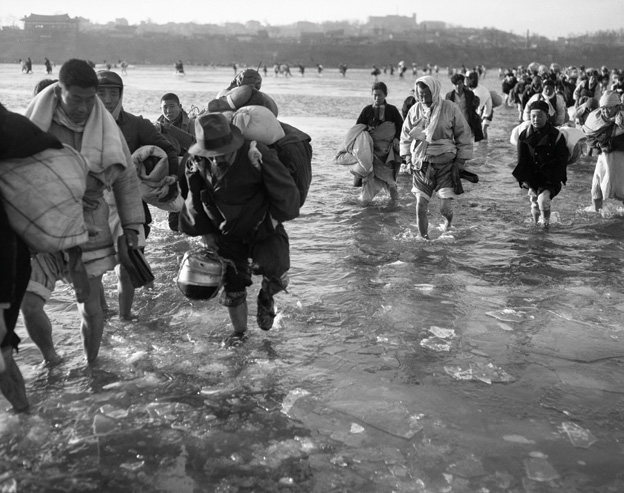It’s been 60 years since the start of the Korean War, which left families and a nation painfully divided. While a great deal of time has since been devoted to crisis scenarios involving the heavily armed peninsula, isn’t it time to plan for a longer-term reality: reunification?
 December 10, 1950. Thousands of Koreans fleeing Pyongyang brave the icy waters of the Taedong River. Photo by Bettmann Collection/CORBIS.
December 10, 1950. Thousands of Koreans fleeing Pyongyang brave the icy waters of the Taedong River. Photo by Bettmann Collection/CORBIS.
By David C. Kang
The tragedy of the Korean War is well known. My own family fled North Korea in 1947, leaving everything behind, from a village in which we had lived since the 16th century. No one has been back to our hometown since then. Our story is not unique: whether they fled the North or lived through the war, almost every Korean family has been affected over the years.
The bitter, costly and bloody war between North and South Korea was an attempt to unify the peninsula by force. Sixty years later, the two sides remain locked in a bitter and tense relationship marked more by confrontation than by reconciliation.
And the recent sinking of South Korean naval vessel Cheonan off the west coast of Korea on March 26 has only raised tensions. With evidence pointing to a North Korean torpedo as the cause (the North has flatly denied the charge), some may wonder whether it even makes sense to talk about the two countries coming together when they seem so poised to destroy each other.
The truth is, unification is more likely to occur from a collapse of the North Korean ruling regime, rather than from a war or sudden invasion.
Indeed, these issues are perhaps more pertinent now than in the past because there is some indication that we may be approaching a major change in North Korea. There is almost no doubt that if the North collapses, the South Korean government will willingly undertake both political unification and the economic burden of revitalizing the northern half of the peninsula. The option of not unifying—and leaving the northern territory to China, Russia or Japan—is unfathomable. I doubt very much whether even the younger generations of South Koreans, who may not value unification highly or who worry about the costs of integrating the two countries, would simply stand by while others claim the land.
Although we would be wise to remain quite cautious in our predictions, Pyongyang is under far greater stress now than when current leader Kim Jong-il took power in 1994. Back then, North Korea had not yet experienced the devastating famine of the late 1990s, had only begun its intense confrontation with the outside world over its nuclear program, and the economy had not yet begun its steep slide into chaos.
In contrast, what we do know about the reclusive nation today is that its leadership faces serious challenges, in addition to the economic malaise and external pressure that it has hitherto managed to survive. These include botched currency reforms that prompted unprecedented public protest and a government apology, questions about Kim Jong-il’s declining health, his on-again-off-again visit to China and doubts about whether his son, Kim Jong-eun, can take and hold power.
If it is indeed true that Pyongyang was behind the Cheonan sinking, it is the most serious North Korean attack since the 1987 bombing of a South Korean airliner, and impossible to ignore. Yet major South Korean or U.S. military action is highly unlikely, given the risks of escalation to all-out war. The costs of a war on the peninsula would be astronomical, so without an imminent and existential threat to the South, the Lee Myung-bak government will not risk starting one.
Instead, South Korean Foreign Minister Yu Myung-hwan has suggested that Seoul may take the issue to the United Nations Security Council. Marginally strengthened economic sanctions and deeper isolation of North Korea would be the likely result, as would further postponement of six-party nuclear disarmament talks.
There are dozens of other rumors flying about, including preparations for a third North Korean nuclear test. Some North Korea watchers believe that the regime is quite stable, and that even if Kim Jong-il were to pass away soon, the regime would maintain its domestic grip, its self-imposed international isolation, and its low-intensity belligerence to the outside world as members of Pyongyang’s leadership brandish their nationalist credentials.
I believe that such a “status quo” option is unsustainable for the North, and that the past year of the country’s provocations indicates serious instability within the elite there. There are so many factors coming to head in the near future that makes it appear that some type of change—for better or for worse—is possible. Various governments as well appear to be giving more attention to the possibility that the North Korean regime might collapse sometime soon.
However, whether unification occurs tomorrow or whether it does not occur until decades from now, actually integrating the two Koreas will be a formidably difficult task. Although traditionally viewed in military terms, collapse and the subsequent unification of the peninsula will, in fact, raise a wide variety of issues, from environmental degradation, legal and judicial issues, and reform of the educational system, to issues of public health and social dislocation. Such issues will affect not only South Korea, but also surrounding countries as well. While a great deal of planning has been devoted to near-term crisis scenarios, in the case of severe instability in the region, there has been very little preparation for these longer-term economic, political and human security issues.
Perhaps it would be better to explore the experience of reconciliation in countries that have gone through bitter civil or ethnic wars, or in which there are great disparities of wealth and education among the people: South Africa, Iraq or the former Yugoslavia. It is true that Korea has no ethnic or racial divisions, but regional sentiments in Korea are quite strong, and culturally, the populations of the two Koreas have diverged sharply in the past 60 years.
We also know from the experience of the few refugees who have fled to the South that they tend to face discrimination because of their accents, and have a tremendously difficult time adjusting to the pace and complexity of modern South Korean life.
Given the decades of propaganda and isolation in the North, and the enormous disparities between north and south in terms of wealth, globalization and development, both sides will face tremendous social and cultural hurdles in unifying.
For the long term, these are the issues the Korean people will have to face. While we may not achieve unification any time soon, planning for such a possibility is an important and necessary task. The sooner we begin, the better prepared we will be.
Certainly, there will be holes in our planning, gaps in our dreams. After all, nations can heal, but some things are gone forever. When Google Earth made available a look at North Korea, I sat and watched my father enter the coordinates and search for his ancestral mountain, his village—his first “visit” to his home in 60 years. The mountain remains; the village has vanished. Slowly, tears rolled down his face and seared their way into my own soul.
David C. Kang is professor of International Relations and Business,
and director of the Korean Studies Institute, at the University of Southern
California. Along with Victor Cha of the Center for Strategic and International Studies, he has embarked on a research project titled, “The Korea Project: Planning for the Long-Term,” to address the issues raised in this column. .







